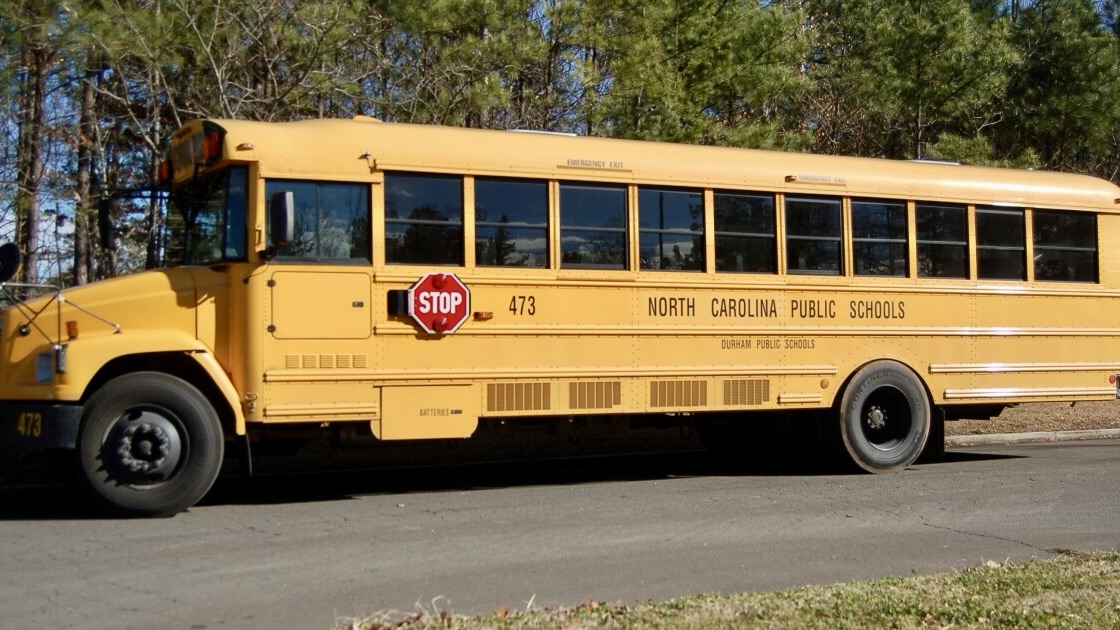Durham Public Schools To Explore New Bus Route Options
Transportation managers at Durham Public Schools (DPS) on Thursday (Oct. 24) expect to discuss tactics within two primary strategies to address ongoing issues with meeting demand for bus routes:
• Increase the available school bus driver workforce (a chronic problem here and across the United States).
• Manage demand for bus ridership.
Beyond hiring new employees to take the wheel for DPS students, the district could offer dual employment to classified workers who obtain a commercial driver’s license with passenger and school endorsements.
The presentation to the Board of Education for Thursday indicates that many school systems in North Carolina require instructional assistants, maintenance, nutrition, and custodial employees to get licensed and be available for bus driving as needed.
“Long-term, consider increased compensation to classified employees with CDL, bilingual, and EC student service,” the presentation states.
This tactic could affect 30 routes within six months, but cost estimates are pending.
The district could also call on licensed, certified, and non-operational DPS employees to drive buses. Currently, DPS has about 60 non-operational employees with CDLs.
“Consider incentives and compensation for administrators, academic services, and operational services staff to work as bus drivers,” the presentation states.
This in-house solution would affect ten routes and could be implemented as soon as possible, but as with the first tactic, cost estimates are pending.
Managing Demand for Transportation
DPS could enforce its “walk zone” policy, requiring families to let their students walk to school or manage their transportation if they live within 1.5 miles of school.
Buses would still serve students with disabilities in these zones or zones where the district determines conditions are too hazardous for walking.
Of the district’s 32 elementary schools, 21 are accessible to pedestrians. Of those:
• 4,327 students live within 1.5 miles of the school.
• 2,466 students within that range requested school bus service.
• 1,800 students live within that range, ask for bus service, and potentially live in a walk zone-eligible area.
For schools that use walk zones, the district could follow three design considerations:
• Students walk along and across 25 mph residential streets.
• Students don’t walk along high-volume streets without sidewalks.
• Students don’t cross streets at speeds higher than 35 mph without a crosswalk beacon, traffic control, or crossing guard.
According to the presentation, this could be implemented in a month and affect 28 routes. No applicable cost estimate is listed.
Durham could establish an “express stop” service for students attending magnet secondary schools without boundaries, such as the School for Creative Studies, Durham School of the Arts, and year-round Rogers-Herr Middle School.
Express bus stops are at strategic DPS locations rather than at a neighborhood stop or family home.
Currently, Rogers-Herr students travel between 45 minutes to an hour on nine routes covering 219 miles. Under the express stop plan, those students would travel 43 miles on seven routes, taking between 20 to 30 minutes.
Transportation officials estimate that this would affect eight routes, with a 75% reduction in miles traveled (766 miles) and an average of 45 minutes less time for student passengers on the bus. This could be implemented within a month. No applicable cost estimate is shown in the presentation.
The district may also consider shaking up its bell-time tiers to allow more time to operate routes. The district uses 45-minute time windows, with elementary school starting at 7:45 a.m., middle schools at 8:30, and high schools at 9:15.
Officials could opt for a 60-minute tier:
• 7:15 a.m.
• 8:15 a.m.
• 9:15 a.m.
Or a 75-minute tier:
• 7 a.m.
• 8:15 a.m.
• 9:30 a.m.
Or perhaps this fourth tier:
• 7:45 a.m.
• 8:30 a.m.
• 9:15 a.m.
• 10 a.m. (specialty schools)
The presentation indicates that earlier elementary and later high school issues “warrant review and limit feasibility.”
For another tactic, the district might provide more staff supervision before and after school, allowing more time to enable double routes to and from the same school.
In the morning, the first bus might unload at 7 a.m., then get another load of students nearby and return within 30 minutes.
In the afternoon, buses would depart for their first quick routes just after dismissal and then return to the same school for another load of students. It’s estimated that this could be implemented within a month, but it requires evaluating fiscal viability and staffing availability.
What About Public Transit?
GoDurham’s 3B bus stops about a quarter mile from Southern School of Energy and Sustainability every hour.
Could transit service become more common at Durham’s secondary schools?
Transportation officials with the school district indicate they need support from GoDurham to ensure stops near schools are prioritized for infrastructure improvements so that they’re ADA accessible with shelters, lighting, benches, and trash cans.
The district also needs to coordinate bus arrivals to avoid student riders consistently showing up late to class due to the 10-minute walk from the bus stop.
Other Agenda Items
When the Board of Education meets this week, members are also expected to get an update on the Growing Together redistricting plan (now moving forward into adjustments for secondary schools), discuss board training, and approve the school treasurer’s list. The consent agenda includes a waste disposal contract, Lyons Farm Elementary School construction, a temporary construction easement at Murray-Massenburg Elementary School, and a discussion about board training.


